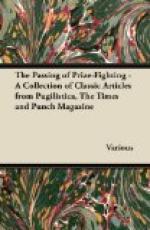“It was interesting
to remember that in the audience on that
occasion were Dante, Gabriel,
Rossetti and Algernon Charles
Swinburne.”—Provincial
Paper.
The archangel was a great catch.
* * * * *
“When the Royal Cream horses were dispersed from the royal stables, one or two golf clubs made an endeavour to get one of these fine animals, and Ranelagh and Sandy Lodge were fortunate to secure them. The horses look fine on the course behind the mower.” Evening Paper.
Shoving, we suppose, for all they are worth.
* * * * *
=EUCLID IN REAL LIFE.=
If it was not for the paper-shortage I should at once re-write EUCLID, or those parts of him which I understand. The trouble about old EUCLID was that he had no soul, and few of his books have that emotional appeal for which we look in these days. My aim would be to bring home his discoveries to the young by clothing them with human interest; and I should at the same time demonstrate to the adult how often they might be made practically useful in everyday life. When one thinks of the times one draws a straight line at right angles to another straight line, and how seldom one does it EUCLID’S way ... every time one writes a T....
Well, let us take, for example—
BOOK III., PROPOSITION 1.
PROBLEM.—To find the centre of a given circle.
Let ABC be that horrible round bed where you had the geraniums last year. This year, I gather, the idea is to have it nothing but rose-trees, with a great big fellow in the middle. The question is, where is the middle? I mean, if you plant it in a hurry on your own judgment, everyone who comes near the house will point out that the bed is all cock-eye. Besides, you can see it from the dining-room and it will annoy you at breakfast.
[Illustration]
CONSTRUCTION.—Well, this is how we go about it. First, you draw any chord AB in the given bed ABC. You can do that with one of those long strings the gardener keeps in his shed, with pegs at the end.
Bisect AB at D.
Now don’t look so stupid. We’ve done that already in Book I., Prop. 10, you remember, when we bisected the stick of nougat. That’s right.
Now from D draw DC at right angles to AB, and meeting the lawn at C. You can do that with a hoe.
Produce CD to meet the lawn again at E.
Now we do some more of that bisecting; this time we bisect EC at F.
Then F shall be the middle of the bed; and that’s where your rose-tree is going.
PROOF???—Well, I mean, if F be not the centre let some point G, outside the line CE, be the centre and put the confounded tree there. And, what’s more, you can jolly well join GA, GD and GB, and see what that looks like.




